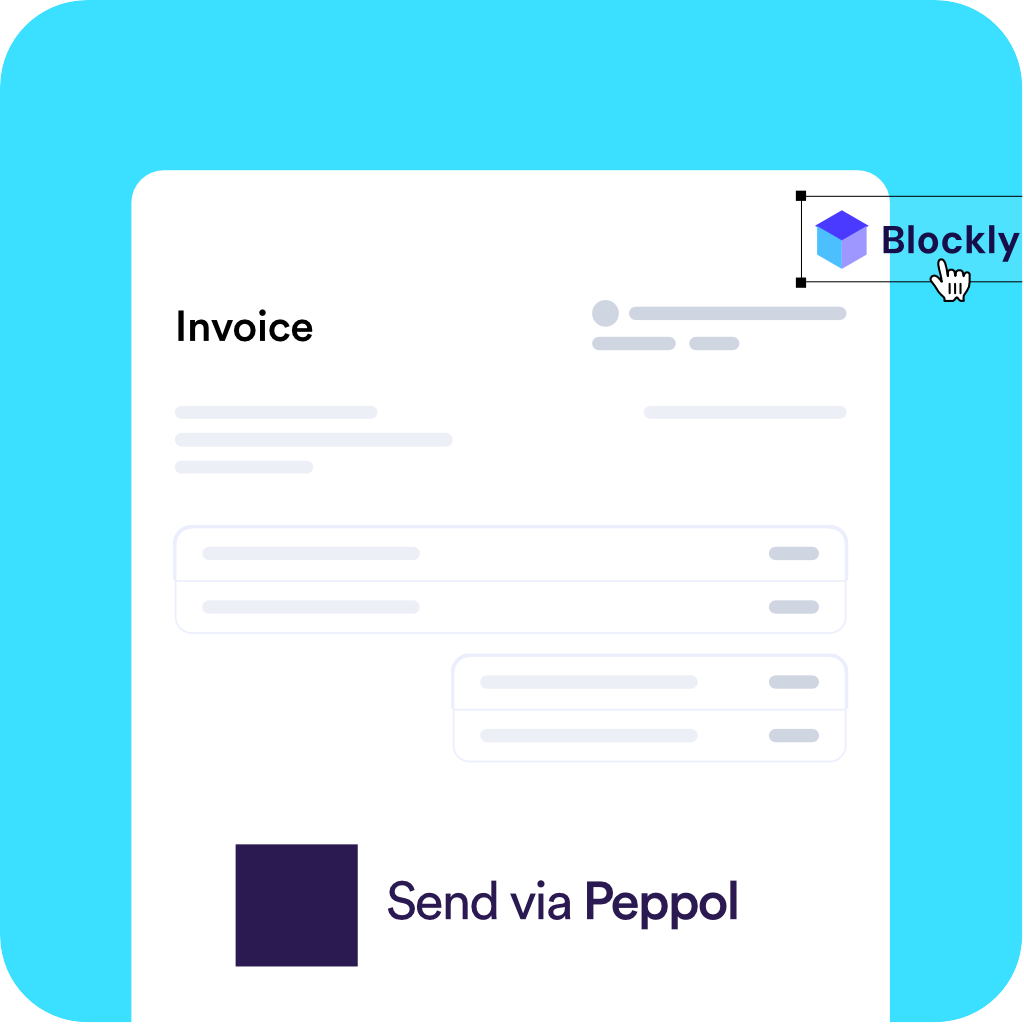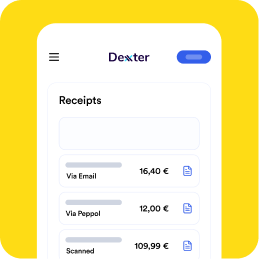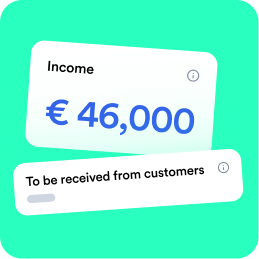Congratulations, you have taken the exciting step of starting your own sole proprietorship! But now the real work is just beginning. After you have taken the legal steps to set up your company, there are several important things you need to address to get your business on track and grow successfully. In this roadmap, we will discuss the essential steps you need to take to start submitting your business.
Step 1. Get started with your bookkeeping🧾
As a sole proprietor, you may do single-entry bookkeeping. It your important to keep accurate records of all purchases, sales and depreciations from the very beginning. There are several ways to make sure your finances are in order and that you meet tax obligations.
You can approach your sole proprietors’ accounting in 3 ways:
- Excel: You can do your bookkeeping yourself in Excel, for example. This is the cheapest option, but unfortunately also has a lot of drawbacks. For example, you already need quite a bit of knowledge of bookkeeping and it is difficult to keep track of all invoices and receipts in 1 place.
- Online accounting tool: For 180 euros a year, Dexxter lets you take control of your bookkeeping. This ensures that everything is 100% correct. Can’t do your bookkeeping? No problem, you can get certified within days via the free accounting course. Dexxter also lets you create invoices, and calculates automatically what you need to fill in on your tax return. Still need some extra advice? Bookkeepers can use the tool free of charge so that your accountant can take a look. Don’t have a bookkeeper yet? Then you can easily schedule a consultation with a bookkeeper.
- Bookkeeper: You can also have your entire bookkeeping done by a bookkeeper. A bookkeeper is the most expensive option, but it means the least work for you.

Step 2. Think about your brand identity 🆔
If you want to start doing business, it is important that you are recognised by your customers. After you find a catchy company name, it’s best to start thinking about your branding. Deciding this in advance will make it easier for you to align all marketing.
What do you all need?
- A logo: this ensures that your brand can be recognised
- Variations of your logo: you might need other formats for your website than for flyers
- Colours: Choose a colour palette and make sure the colours are good matches
- Fonts: Choose two to four fonts that go well together. You can use your font in all communications. For your website, for example, think of a font for titles, text and buttons.

Tip:
A small budget? You might want to hire someone through Fiverr or design your own logo and branding
Step 3. Build a website 🌐
An online presence is crucial in the modern business world. Invest in a professional website that clearly presents your services and products. There are several options for building a website: Shopify, Wix, Google Sites, Squarespace… each provider has its own advantages and disadvantages. You can create your website yourself, or you can pay someone to do it for you. It’s a lot cheaper to do it yourself and a lot of website providers don’t require you to know anything at all about programming.
Buy a domain name that suits your company and consider buying multiple extensions such as .com and .be. A domain name with extension costs less than 10 euros per year per domain name, not a lot of money.
Step 4. Start social media channels 📢
Log in your company to various social media channels. Instagram, Tiktok, Linkedin and Youtube are good websites to start with. LinkedIn can be invaluable for attracting B2B customers and building professional relations, so create a company page as well.
Social media allows people to get to know your company. But even if you don’t plan to be enabled on social media, it’s important to claim your company name on platforms, that way no one can steal your name.

Step 5. Register your company on Google 🌐
An important step to improve your local visibility is to register your company on Google. This will enable potential customers to easily find your company when they search for products or services locally.
Registering your company on Google is free and has many benefits:
- Finding local customers: By registering your company on Google, you increase the chances of local customers discovering you. This is especially valuable if you have a local company, such as a restaurant, shop or services provider.
- Good to be found: People rely on Google to find companies. Having a listing on Google My Business means you will be shown in Google search results and Google Maps, which increases your company’s credibility and findability.
- Collecting reviews: Through Google My Company, customers can easily leave reviews. Positive reviews help build trust with potential customers. Encourage satisfied customers to leave reviews to strengthen your reputation.
- Opening hours and contact details: You can update important information such as your opening hours and contact details on your Google My Company page, which is useful for customers who want to find information quickly.
Step 6. Don’t be afraid to invest💶
In the beginning, you probably don’t make much money with your sole proprietors yet, so it can be a bit scary to spend money. But sometimes you have to spend expenses to make money. Invest in the necessary equipment, marketing and training to grow and improve your company.

“I put off buying a ring lamp for filming for a very long time, but now that I have 1, I can’t live without it. It’s so much smoother to create marketing content now!”
– Louise Dillen, Marketing Freelancer
Once people have made an investment, they often think ‘amai, this makes my life so much easier, I should have done that earlier.’ To know whether an investment is worth it, it’s best to look at a few aspects:
- Time: does it save you time? Does it make your life easier? Sometimes small purchases can mean a world of difference
- Money: will it make you more money in the long term? If so, it’s definitely recommended!
- Convenience: will the investment make tasks happen automatically?

Remember:
If you incur expenses for your company then you will also be taxed on a smaller amount.
Step 7. Question a bank card 💳
Although it is not required for sole proprietors to have a business account, it is highly recommended to open one. This can often be done free or very cheaply, and it’s simple! Often it can be done simply online or with a quick call to your bank. It is essential to keep your personal and business finances separate, as this allows you to keep a summary of your cash flow. This makes managing your cash flows much easier.
After you have an account, it’s also best to question a bank card. This way, you can easily make payments in shops and to suppliers. Moreover, a tax inspector can then only check your business account.
Step 8. Find your first customers 👥
Finding your first customers can sometimes be difficult, as no one knows your company. Fortunately, there are lots of ways to change that! Usually, the first customers of a new company come from close by. Think about family and friends, maybe they could use your help? If so, don’t be afraid to contact them!
After that, you can start identifying potential customers. Approach them with your offer by email, phone number or pop in. Networking and word of mouth can be valuable ways to find your first customers.
Consider giving your first customers a discount. This way, you can thank them for their trust. Do you deliver good work? Then you are likely to have a loyal customer for several years.
If you still don’t succeed in finding customers right away, challenge yourself to complete a ‘fake job’. Pretend it is an assignment for a customer, and work it out. This way, you will learn and have something concrete to show to potential customers. Moreover, you can create content for your website and social media that will allow you to show potential customers what you can do.

Step 9. Online marketing
Online, there are lots of places to advertise. This can be free via your website and social media, but you can also pay for paid online advertising. The possibilities from paid advertising are endless: social media ads, appearing higher in Google, display ads… It costs some money but you can increase your visibility and drive potential customers to your website.
What is recommended is to create a few posts first to see what works within your target audience. Do you get a lot of interaction on a certain type of posts? Then you can use it to advertise to new customers. It is advisable to invest 2-5% of your turnover in marketing.
For your company, try to calculate how much a new customer can cost. If you only have a 20 euro margin per customer, a new customer should not cost you very much. On the other hand, if a conversion brings you 2000 euros, you can invest a bit more in marketing.
Step 10. Offline marketing
Digital marketing is ubiquitous, but don’t forget traditional advertising methods. Print some flyers, posters and business cards. This is how you bring local attention to your company and increase brand awareness. There are lots of possibilities!

Want extra advertising?
Maybe you can add a sticker with your logo on your car?
Step 11. Think about your inventory
If you sell physical products, make sure you manage your inventory to avoid running out of stock or having too much stock. Keeping an inventory is expensive, after all, you have to pay for each product in advance and you are not sure if it will be sold.
To avoid this, there are a few things you can do:
- Search for a supplier with a low MOQ, which means ‘minimum order quantity’. This means you don’t have to invest a lot at once.
- Convince customers to buy multiple items, for example by giving a discount on the second item.
- Work with pre-orders: You only have to order after people have placed their orders, which means you have a longer delivery time for your customers, but also makes you look more exclusive.

Did you know.
You should also report your inventory to taxes. After all, using inventory is a cost.
Step 12. See if you qualify for subsidies
The government, companies and cities often give grants to innovative, sustainable or social initiatives. It never hurts to search their websites to see if you would qualify. A nudge can be a good help at the start!

Step 13. Question advice from others
It can sometimes be difficult to accept criticism when you are fully committed to something. Nevertheless, it is very advisable to learn to deal with criticism. If you let people give advice about your website, prices, marketing… you can improve a lot because of it.
Talk to other start-ups, to friends, to your target audience, to experienced entrepreneurs… a network is very important and you can learn a lot from it.
Step 14. Keep a good record of your tasks
As a sole proprietor you have to be a specialist in many areas and you have to think of everything. Having to do everything on your own can be quite stressful. Fortunately, there are solutions to keep things in order. Think for example of tools to keep track of your tasks, such as Monday or Trello.

Step 15. Create a template for your invoices
If you have to send an invoice to a company, you want it to at least look professional. Then, when you get to send out an invoice, you can easily update the details.
There should be an amount of information required on invoices:
- The word ‘Invoice’
- Your name and full address
- Your business bank account number
- Your vAT number and that of your customer
- The customer’s name and full address
- The invoice number
- The invoice date
- The quantity and type of goods and services provided
- The payment terms

Did you know?
With Dexxter, you can easily create invoices. They are automatic 100% okay.
Step 16. Think about your packaging materials and shipping 📦
Do you have a physical product? Then you will need to send it to your customers. Your packaging material can make a good first impression. You can personalise packaging material, but keep in mind that the more you personalise, the more expensive it often becomes.
- Shipping boxes: You can order shipping boxes and shipping bags inexpensively on Raja or Amazon, but there are also more sustainable alternatives. Expect to pay around 50 cents for a box, and 30 cents for a bag.
- Personalisation: You might like to personalise your parcel from stickers, a stamp, a thank-you card, etc.
- Protection: If your product is fragile, you can save return costs by protecting it from paper or bubble wrap.
- Courier service: Bpost and Mondial Relay are commonly used and each has its own pros and cons. If you send a lot of parcels, you can sometimes get a discount.
Tip: you can request free packaging material through UPS

Step 17. Write down important dates 📅
Keep a diary with important dates, such as due dates for invoices, meetings and events relevant to your company. Don’t forget your accounting dates here, too . For example, as a self-employed person, you have to pay provisional contributions for your social security contributions and you can also make advance payments for your personal income tax.
Some important dates are:
- Every quarter: deadline for advance payments of taxes
- October: personal income tax
- Each quarter: deadline vAT declarations
- …
Step 18. Tax return
Make sure you are aware of your sole proprietors’ tax obligations and file your tax return on time to avoid penalties. If you are a sole proprietor, file your taxes along with your personal tax return. The deadline for this is October.
Important here is that:
- You add all invoices to your accounts
- You keep good records of all business expenses you incur
- You have properly noted your daily receipts
Your results should be filled in in step 2 from taxes. Don’t know much about taxes? No problem! Just fill in all your details on Dexxter, and the tool will tell you exactly where to fill in what.















